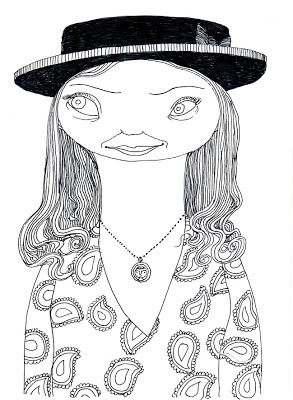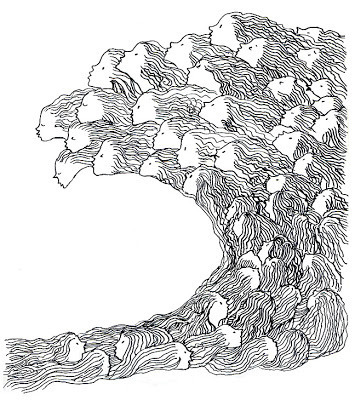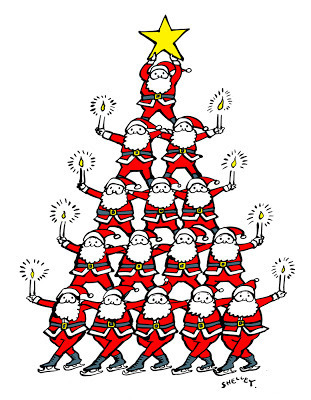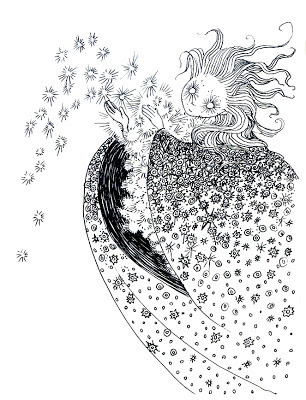John Shelley's Blog, page 13
March 21, 2013
What I Love about Old Books
There's so much talk about new technology, of tablets and Apps, e-Books versus print publishing, it's difficult to know where you stand sometimes. None of us wants to be left behind in this digital revolution, we're told that e-publishing is a path of opportunity for illustrators. That's good news, I'm all for new opportunities, I must admit to being amazed by what can be achieved with technology. Nevertheless I'm not sure where I personally fit into this heady world of new media. I suppose I'm enthusiastic for, but not an avid enthusiast of ebooks and their like.
The more I contemplate ebooks, the more I think back to why I pursued the publishing industry in the first place. I thought I'd take a moment then to post a bit about what I love about old books. And I mean old books!
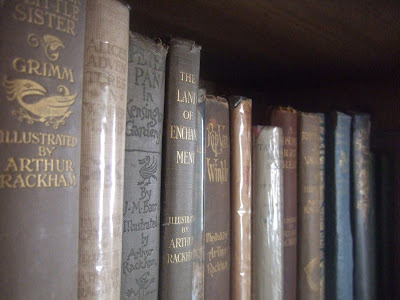
Golden Age treasures
I became an illustrator as the result of a love affair with books, initially from childhood trips to the library, where I discovered Edward Ardizzone, Quentin Blake and E.H. Shepherd, and fascination with the illustrations in my mum's old 1920's volumes of Fairy Tales. Thereafter I became absorbed in coffee-table art and history books showing the work of painters, engravers and especially graphic masters like Hogarth and Rowlandson. And then at the particularly impressionable age of 15, came the discovery of the Golden Age illustrators: Arthur Rackham, Edmund Dulac, the Robinson brothers and their contemporaries, and I was transported, head-over-hills, to kingdoms far away. When it comes to books, I'm an incurable romantic.
In this post though, rather than the illustrators and their work I want to focus on the media - the printed books. Aside from the superlative quality of the art, the production of the books themselves was an inspiration in their own right, especially the lavish Gift Books of the era. Years ago I began collecting First and Deluxe edition titles from the Golden Age, mostly Arthur Rackham but others too, sometimes through auction, some via antiquarian bookshops. I won't go on about the years spent blissfully rummaging through the
shelves of antiquarian and second-hand bookshops looking for hidden rare
nuggets. Suffice to say - I'm a disciple, pen and ink masters have
enraptured me throughout my career. Despite all the upheavals in my life over the years I still have a couple of bookshelves enshrined as homage to my heroes.
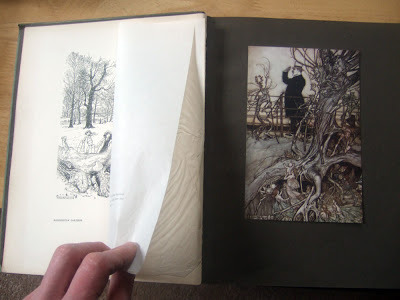
The first Gift Book I got hold of was this battered 1912 edition of Peter Pan in Kensington Gardens, which remains one of my favorite books illustrated by Arthur Rackham. Published by Hodder & Stoughton, it was printed by T & A Constable in Edinburgh.
What is the "Golden Age"? In loose terms, it's the period between the broad introduction of modern photographic 4-colour printing in the 1870's (when for the first time the work of illustrators could be reproduced exactly as the original art) and the close of the First World War, which heralded a change in publishing tastes and budgets.
What is a "Golden Age Gift Book"? Usually these were large sized (quarto or similar) books, often released to time with the Christmas season to be presented as gifts. Collected fairy tales, classics and modern fantasies were most common. The standard 'trade' editions were of cloth binding with inlaid gold lettered cover, often including illustration and designed by the illustrator themselves. In contrast dust jackets were often quite austere and surviving examples are rare today.
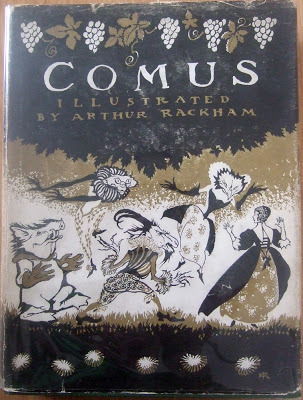
Cover of Milton's Comus with Rackham's Dust Jacket. Published by Heinemann, printed by The Cornwall Press in London in 1921.
The books were printed in letterpress on high quality heavy paper, with generously wide margins, and often interspersed with black and white illustrations. The pages were sometimes left untrimmed, leaving a rough uneven edge, all of which adds to the sense of quality.
The real stamp of the gift book though were the colour illustrations. As the process of photo-litho colour reproduction was quite new, colour illustrations were printed on separate sheets of coated art paper 'plates', which were glued down onto coloured mounting sheets, usually just along one edge, and covered with a sheet of tracing paper carrying the image caption. The tracing paper was ostensiably to protect the delicate colour image from rubbing on the paper, though it was soon clear this was unnecessary and the practice became more for show and to convey a sense of exclusivity. These were then bound into the book separately.
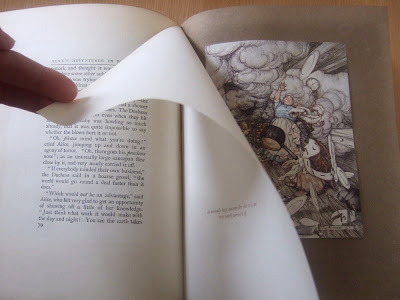
Deluxe edition of Rackham's 1907 Alice's Adventures in Wonderland - big margins, tipped in colour plate and tissue guard.
For me there is no other reading experience more satisfying than browsing through these books. The sense of lifting the tracing paper to see the gem of illustration beneath is a pleasure only books can give. These are books to be read with deference. The trade editions were intended to be read, re-read and treasured by children and adults, and they still have that effect today. There will never be an App that gives me the same glow as handling these old tomes.
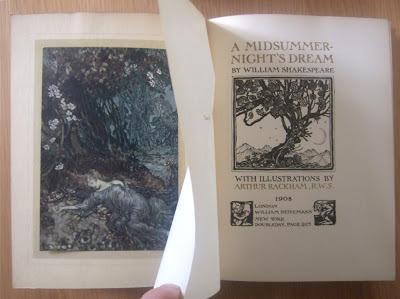
Title page of the 1908 Trade first edition of Rackham's Midsummer Night's Dream. Again published by Heinemann, and printed by The Ballantyne Press in London.
More elevated still though are the signed deluxe limited editions. Ordinary Trade editions would run to 15,000 or more for their first impression, but for the top selling artists a limited number of specially bound deluxe editions would be printed, generally between 350 and 1,000 copies only, each numbered and signed by the artist. The deluxe editions were larger and heavier than the trade editions, usually bound in heavy buckram rather than cloth, with ribbon ties (few of these survive) and sometimes with an extra illustration. These are my Deluxe edition Rackham's :
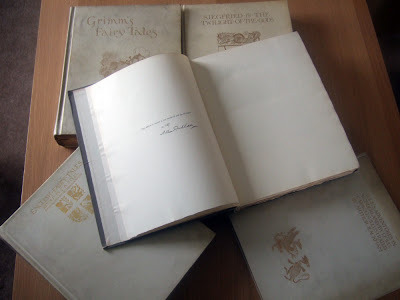
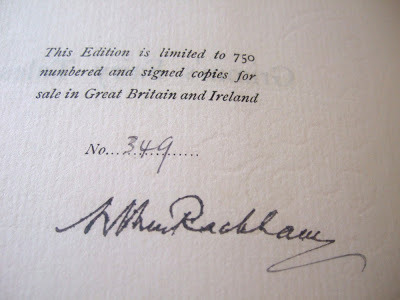
These books demand a lot of respect. Running my fingers lightly over the page, I can feel the impressions of the text and black and white illustrations pushed into the surface of the paper by the blocks, the creak of the spine as I slowly, methodically turn each page, then the wonderful sense of anticipation as I reach a colour illustration and peel back the delicate tracing paper to reveal the image beneath. The limited editions have a more exclusive quality to them, the pages more difficult to turn, not for prying children's grubby fingers. And that kind of defeats the object of the book! So as reading books I actually much prefer the trade editions, though I still occasionally read to my daughter at night from signed copies of Rackham's 1909 Grimm or 1918 English Fairy Tales.
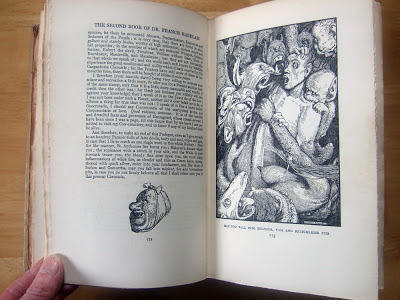
One of William Heath Robinson's greatest works, and long before the contraptions that made him a household name - The Works of Rabellais, originally published in 1904, this is the Navarre Society edition 1921, printed by Richard Clay & Sons in Bungay, Suffolk
Though such Gift Books went out of fashion in the 1920's, very fine books by smaller presses continued to be made until World War 2 knocked the stuffing out of the market. Fine books have returned since then of course. I've always dreamed of seeing my books made like those of my heroes. This is not an ambition with much likelihood of success, though I knew that before I became an illustrator. It didn't stop me dreaming though, I'll never forget the first time I handled these old books, my love for children's illustration and the Golden Age era in particular is what set me on the determined path to follow in the footsteps of the "greats".
It's not only the big Edwardian gift books I get excited about though, any old well illustrated book is liable to attract my attention, my collection ranges from books big or small, finely produced or WW2 budget printing. This is all in addition to the shelves of modern picture books etc. I've precious little space for anything now, though I did relinquish a lot of books when I moved back to the UK, some which I now regret.
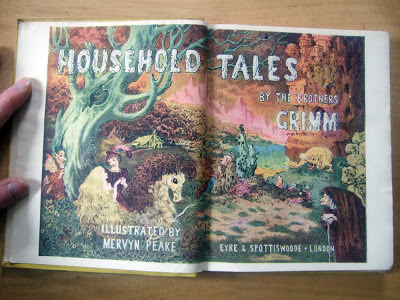
War economy edition of Mervyn Peake's Household Tales by the Brothers Grimm, published by Eyre and Spottiswoode and printed by Chapel River Press in 1946.
The oldest books in my little collection are not children's books at all, but a handful of military diaries from the 1790's, published campaign reports of officers serving under the Grand old Duke of York in Flanders in the early wars of the French Revolution (it's a period I've long been fascinated by). Few of these are illustrated, but they do contain some beautifully detailed engraved maps and calligraphy. Though very different from the Golden Age books, I love them just as much. The sense of these works being published in the forefront of such incredible times adds to the fascination.
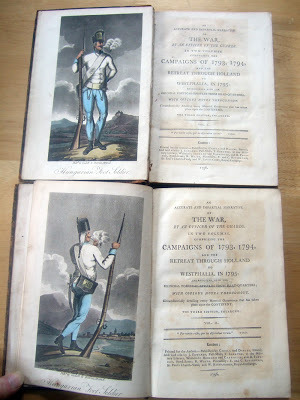
Frontespiece of the two volumes of
An Accurate and Impartial Narrative of the War, by
an Officer of the Guards in Two Volumes Comprising the Campaigns of
1793, 1794, and the Retreat Through Holland to Westphalia in 1795. Published by Cadell and Davies in 1796.
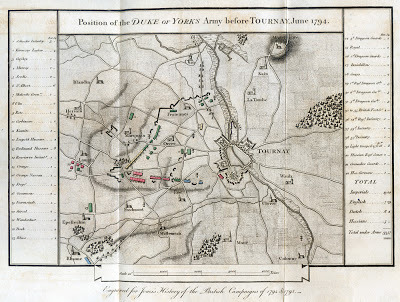
Map of the Duke of York's position at Tournai, June 1794 in Jones's History of the British Campaigns of 1794 & 1795. Printed by Swinney and Hawkins in Birmingham 1797.
So that's my little indulgence. I don't add to the collection nowadays, budget, space and circumstances prevent that, but I'm holding onto what I've got. These books have travelled with me from the UK to Japan and back again so I'm not about to get rid of any of them soon.
E-books may be an exciting future for children's publishing, and I certainly aim to be part of that. But alongside the digital boom many publishers are saying that a new focus on collectable, well produced, carefully crafted books is also a way forward to re-ignite the traditional printed book market. I think that's very good news.
The more I contemplate ebooks, the more I think back to why I pursued the publishing industry in the first place. I thought I'd take a moment then to post a bit about what I love about old books. And I mean old books!

Golden Age treasures
I became an illustrator as the result of a love affair with books, initially from childhood trips to the library, where I discovered Edward Ardizzone, Quentin Blake and E.H. Shepherd, and fascination with the illustrations in my mum's old 1920's volumes of Fairy Tales. Thereafter I became absorbed in coffee-table art and history books showing the work of painters, engravers and especially graphic masters like Hogarth and Rowlandson. And then at the particularly impressionable age of 15, came the discovery of the Golden Age illustrators: Arthur Rackham, Edmund Dulac, the Robinson brothers and their contemporaries, and I was transported, head-over-hills, to kingdoms far away. When it comes to books, I'm an incurable romantic.
In this post though, rather than the illustrators and their work I want to focus on the media - the printed books. Aside from the superlative quality of the art, the production of the books themselves was an inspiration in their own right, especially the lavish Gift Books of the era. Years ago I began collecting First and Deluxe edition titles from the Golden Age, mostly Arthur Rackham but others too, sometimes through auction, some via antiquarian bookshops. I won't go on about the years spent blissfully rummaging through the
shelves of antiquarian and second-hand bookshops looking for hidden rare
nuggets. Suffice to say - I'm a disciple, pen and ink masters have
enraptured me throughout my career. Despite all the upheavals in my life over the years I still have a couple of bookshelves enshrined as homage to my heroes.

The first Gift Book I got hold of was this battered 1912 edition of Peter Pan in Kensington Gardens, which remains one of my favorite books illustrated by Arthur Rackham. Published by Hodder & Stoughton, it was printed by T & A Constable in Edinburgh.
What is the "Golden Age"? In loose terms, it's the period between the broad introduction of modern photographic 4-colour printing in the 1870's (when for the first time the work of illustrators could be reproduced exactly as the original art) and the close of the First World War, which heralded a change in publishing tastes and budgets.
What is a "Golden Age Gift Book"? Usually these were large sized (quarto or similar) books, often released to time with the Christmas season to be presented as gifts. Collected fairy tales, classics and modern fantasies were most common. The standard 'trade' editions were of cloth binding with inlaid gold lettered cover, often including illustration and designed by the illustrator themselves. In contrast dust jackets were often quite austere and surviving examples are rare today.

Cover of Milton's Comus with Rackham's Dust Jacket. Published by Heinemann, printed by The Cornwall Press in London in 1921.
The books were printed in letterpress on high quality heavy paper, with generously wide margins, and often interspersed with black and white illustrations. The pages were sometimes left untrimmed, leaving a rough uneven edge, all of which adds to the sense of quality.
The real stamp of the gift book though were the colour illustrations. As the process of photo-litho colour reproduction was quite new, colour illustrations were printed on separate sheets of coated art paper 'plates', which were glued down onto coloured mounting sheets, usually just along one edge, and covered with a sheet of tracing paper carrying the image caption. The tracing paper was ostensiably to protect the delicate colour image from rubbing on the paper, though it was soon clear this was unnecessary and the practice became more for show and to convey a sense of exclusivity. These were then bound into the book separately.

Deluxe edition of Rackham's 1907 Alice's Adventures in Wonderland - big margins, tipped in colour plate and tissue guard.
For me there is no other reading experience more satisfying than browsing through these books. The sense of lifting the tracing paper to see the gem of illustration beneath is a pleasure only books can give. These are books to be read with deference. The trade editions were intended to be read, re-read and treasured by children and adults, and they still have that effect today. There will never be an App that gives me the same glow as handling these old tomes.

Title page of the 1908 Trade first edition of Rackham's Midsummer Night's Dream. Again published by Heinemann, and printed by The Ballantyne Press in London.
More elevated still though are the signed deluxe limited editions. Ordinary Trade editions would run to 15,000 or more for their first impression, but for the top selling artists a limited number of specially bound deluxe editions would be printed, generally between 350 and 1,000 copies only, each numbered and signed by the artist. The deluxe editions were larger and heavier than the trade editions, usually bound in heavy buckram rather than cloth, with ribbon ties (few of these survive) and sometimes with an extra illustration. These are my Deluxe edition Rackham's :


These books demand a lot of respect. Running my fingers lightly over the page, I can feel the impressions of the text and black and white illustrations pushed into the surface of the paper by the blocks, the creak of the spine as I slowly, methodically turn each page, then the wonderful sense of anticipation as I reach a colour illustration and peel back the delicate tracing paper to reveal the image beneath. The limited editions have a more exclusive quality to them, the pages more difficult to turn, not for prying children's grubby fingers. And that kind of defeats the object of the book! So as reading books I actually much prefer the trade editions, though I still occasionally read to my daughter at night from signed copies of Rackham's 1909 Grimm or 1918 English Fairy Tales.

One of William Heath Robinson's greatest works, and long before the contraptions that made him a household name - The Works of Rabellais, originally published in 1904, this is the Navarre Society edition 1921, printed by Richard Clay & Sons in Bungay, Suffolk
Though such Gift Books went out of fashion in the 1920's, very fine books by smaller presses continued to be made until World War 2 knocked the stuffing out of the market. Fine books have returned since then of course. I've always dreamed of seeing my books made like those of my heroes. This is not an ambition with much likelihood of success, though I knew that before I became an illustrator. It didn't stop me dreaming though, I'll never forget the first time I handled these old books, my love for children's illustration and the Golden Age era in particular is what set me on the determined path to follow in the footsteps of the "greats".
It's not only the big Edwardian gift books I get excited about though, any old well illustrated book is liable to attract my attention, my collection ranges from books big or small, finely produced or WW2 budget printing. This is all in addition to the shelves of modern picture books etc. I've precious little space for anything now, though I did relinquish a lot of books when I moved back to the UK, some which I now regret.

War economy edition of Mervyn Peake's Household Tales by the Brothers Grimm, published by Eyre and Spottiswoode and printed by Chapel River Press in 1946.
The oldest books in my little collection are not children's books at all, but a handful of military diaries from the 1790's, published campaign reports of officers serving under the Grand old Duke of York in Flanders in the early wars of the French Revolution (it's a period I've long been fascinated by). Few of these are illustrated, but they do contain some beautifully detailed engraved maps and calligraphy. Though very different from the Golden Age books, I love them just as much. The sense of these works being published in the forefront of such incredible times adds to the fascination.

Frontespiece of the two volumes of
An Accurate and Impartial Narrative of the War, by
an Officer of the Guards in Two Volumes Comprising the Campaigns of
1793, 1794, and the Retreat Through Holland to Westphalia in 1795. Published by Cadell and Davies in 1796.

Map of the Duke of York's position at Tournai, June 1794 in Jones's History of the British Campaigns of 1794 & 1795. Printed by Swinney and Hawkins in Birmingham 1797.
So that's my little indulgence. I don't add to the collection nowadays, budget, space and circumstances prevent that, but I'm holding onto what I've got. These books have travelled with me from the UK to Japan and back again so I'm not about to get rid of any of them soon.
E-books may be an exciting future for children's publishing, and I certainly aim to be part of that. But alongside the digital boom many publishers are saying that a new focus on collectable, well produced, carefully crafted books is also a way forward to re-ignite the traditional printed book market. I think that's very good news.
Published on March 21, 2013 05:24
March 6, 2013
When in doubt......
Published on March 06, 2013 01:14
February 14, 2013
Doodles on the train
So yes, last weekend I was off on the train for a couple of hours, as promised I was drawing all the way. However due to the constraints of reserved seat allocation and tightly tiered seat layouts, many Eastern region trains don't offer themselves easily to sketch the other passengers. (That is a grumble, yes!) On the outward journey this is as much as I was able to see:
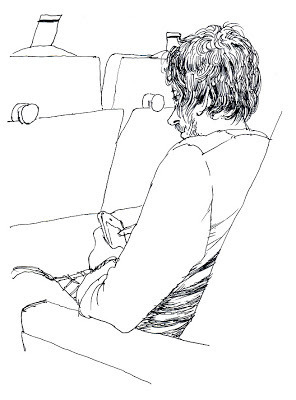
On the return I virtually had the carriage to myself, so again, no sketching from life. However, at times like these the pen has other invisible realms to explore ......
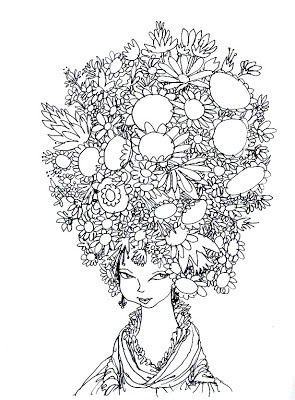
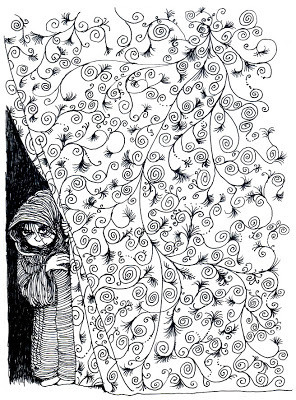

On the return I virtually had the carriage to myself, so again, no sketching from life. However, at times like these the pen has other invisible realms to explore ......


Published on February 14, 2013 02:21
February 7, 2013
Train Sketches
Some of the quick life sketches I drew on crowded trains in Tokyo last summer.
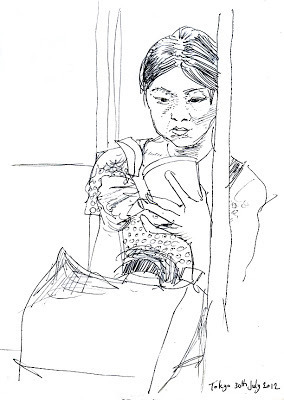
I find drawing on busy commuter trains exhilarating. You never know whether your view is going to be blocked as the carriage fills with people, or whether the subject is going to shift position, get off at the next stop, or notice they're being drawn and feel uncomfortable. The trick is not to draw the person in front of you but one sitting further down the carriage. You draw rapidly and surreptitiously from sideways glances, getting as much information down, as quickly as you can.
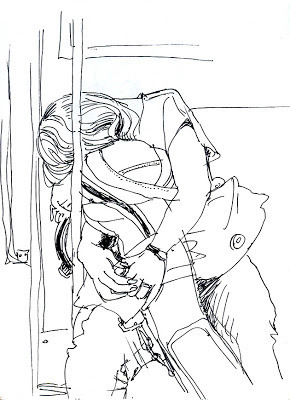
Dozing passengers are a safe option!
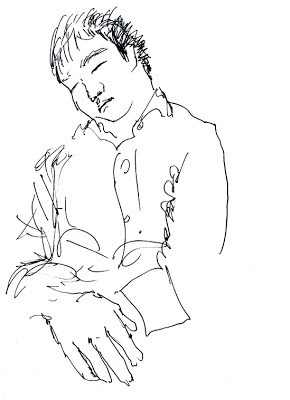
Often the resulting pen line can have a nervous energy that might be hard to achieve in more considered drawings, the white spaces have a natural compositional dynamism . I'm often surprised by the results.
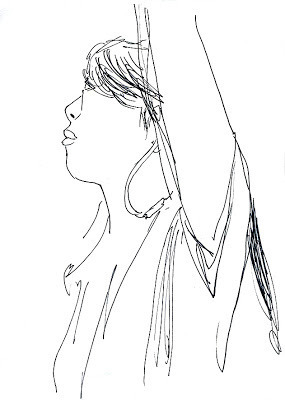
I tend to draw more on Japanese trains than those in the UK, crowded trains with standing passengers offer unusual angles and it's easier on the Japanese networks because all the seats are against the carriage walls facing each other. London tube trains have similar layouts but more cramped so I find them a little too intimate for sketching passengers.
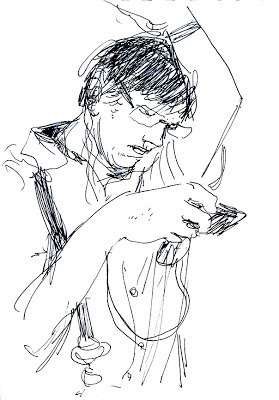
Tomorrow I'm off on a 2 hour train journey though, so if I get any drawing done I'll post when I get back!

I find drawing on busy commuter trains exhilarating. You never know whether your view is going to be blocked as the carriage fills with people, or whether the subject is going to shift position, get off at the next stop, or notice they're being drawn and feel uncomfortable. The trick is not to draw the person in front of you but one sitting further down the carriage. You draw rapidly and surreptitiously from sideways glances, getting as much information down, as quickly as you can.

Dozing passengers are a safe option!

Often the resulting pen line can have a nervous energy that might be hard to achieve in more considered drawings, the white spaces have a natural compositional dynamism . I'm often surprised by the results.

I tend to draw more on Japanese trains than those in the UK, crowded trains with standing passengers offer unusual angles and it's easier on the Japanese networks because all the seats are against the carriage walls facing each other. London tube trains have similar layouts but more cramped so I find them a little too intimate for sketching passengers.

Tomorrow I'm off on a 2 hour train journey though, so if I get any drawing done I'll post when I get back!
Published on February 07, 2013 10:12
January 31, 2013
Wingspan
In the meantime and in an altogether different vein, here are some more of the small regular monthly cuts I do for Japanese airline ANA's inflight magazine Wingspan.
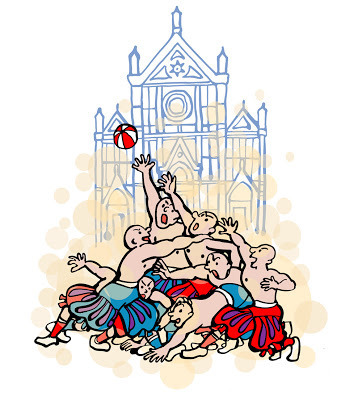
The Calcio Storico festival in Florence, Italy
Every issue the magazine runs a short nugget feature covering the weird and unusual things that happen around the world. Often they're very amusing subjects and a lot of fun to draw. However the drawings themselves are always gentle observations, not outright humour.
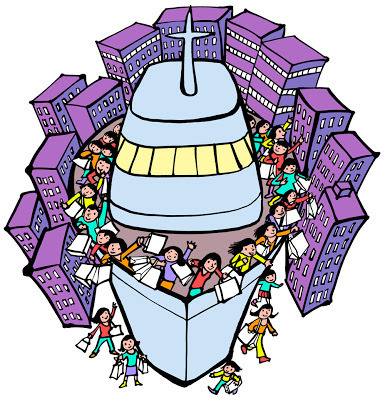
Hong Kong - A ship-shaped department store
Unlike my more detailed children's books, which are created on watercolour paper, for this kind of work I draw on a coated paper which results in a strong expressive pen line, a style I first developed for posters and other graphic work in Japan.
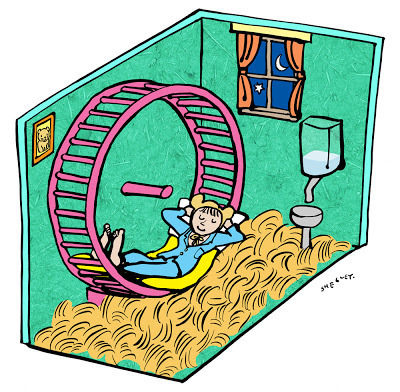
A Hotel in France where guests can live like hamsters
The drawings are scanned in, often assembled from several elements, cleaned up and then coloured digitally, sometimes using textures. I love the flexibility that this offers.
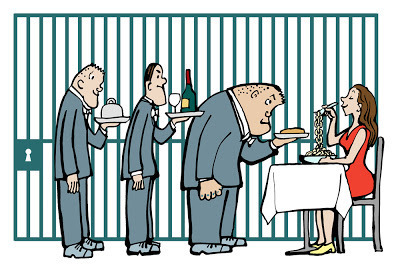
A restaurant in an Italian prison, where inmates serve the customers
I particularly enjoy this kind of work because it allows me to play
around on the computer and explore graphic simplicity, though I don't regard myself as a "digital
artist", everything still rests on a hand-crafted pen and ink drawing.
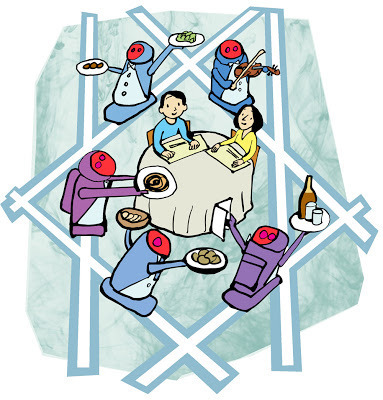
A restaurant in China run entirely by robots
My children's books are created almost entirely by traditional non-digital means which gives a natural resonance, but in these illustrations the stronger line and digital colouring provides a more dynamic graphic edge. This style of work appears to be unconnected to my pen and watercolour children's books, but in fact they both come from exactly the same pen, it's just the paper and colouring that's different. Just varied facets of the same realm.
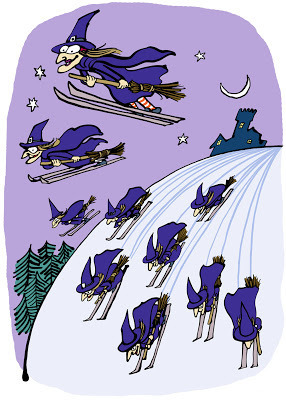
The latest issue talks about a Ski Festival of Witches in Switzerland

The Calcio Storico festival in Florence, Italy
Every issue the magazine runs a short nugget feature covering the weird and unusual things that happen around the world. Often they're very amusing subjects and a lot of fun to draw. However the drawings themselves are always gentle observations, not outright humour.

Hong Kong - A ship-shaped department store
Unlike my more detailed children's books, which are created on watercolour paper, for this kind of work I draw on a coated paper which results in a strong expressive pen line, a style I first developed for posters and other graphic work in Japan.

A Hotel in France where guests can live like hamsters
The drawings are scanned in, often assembled from several elements, cleaned up and then coloured digitally, sometimes using textures. I love the flexibility that this offers.

A restaurant in an Italian prison, where inmates serve the customers
I particularly enjoy this kind of work because it allows me to play
around on the computer and explore graphic simplicity, though I don't regard myself as a "digital
artist", everything still rests on a hand-crafted pen and ink drawing.

A restaurant in China run entirely by robots
My children's books are created almost entirely by traditional non-digital means which gives a natural resonance, but in these illustrations the stronger line and digital colouring provides a more dynamic graphic edge. This style of work appears to be unconnected to my pen and watercolour children's books, but in fact they both come from exactly the same pen, it's just the paper and colouring that's different. Just varied facets of the same realm.

The latest issue talks about a Ski Festival of Witches in Switzerland
Published on January 31, 2013 07:07
January 30, 2013
Working Catch-up
I've been quiet on the blog of late, in fact all social media, largely due to work on my latest picture book, Jane Sutcliffe's renaissance non-fiction The Stone Giant - Michelangelo's David and How He Came to Be. It's been an involving project in the pipeline for quite a while, with several interruptions (like an unforeseen house move!) but I'm happy to say the art work is now complete! Currently awaiting final approval before posting the art off, I'll be able to share some images shortly.
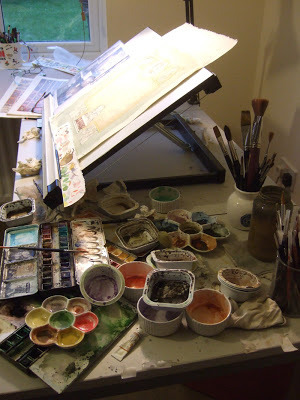
Desktop debris, in the middle of wrestling with Michelangelo!

Desktop debris, in the middle of wrestling with Michelangelo!
Published on January 30, 2013 08:29
January 5, 2013
New Year Greetings
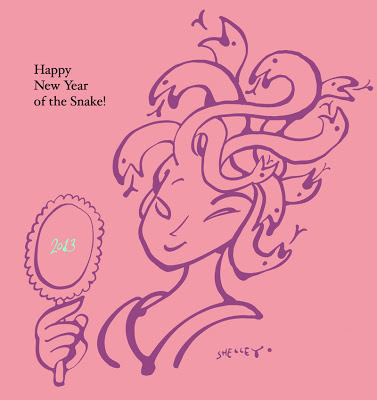
Somewhat belated 2013 greetings this year as I've been absolutely overwhelmed. Nevertheless it's still early, here's for a legendary Year of the Snake, may all your gorgons be gorgeous!
Published on January 05, 2013 12:46
December 19, 2012
Seasons Greetings
Published on December 19, 2012 13:21
November 29, 2012
Nebula
Published on November 29, 2012 08:51
November 12, 2012
Recent Doodles
I've not posted any sketches for a while, largely because I've been grappling with a mountain of things from very involved deadlines to house moving. I have been drawing though in brief moments of solace, so it's about time I posted something! Here's a couple of meandering doodles....
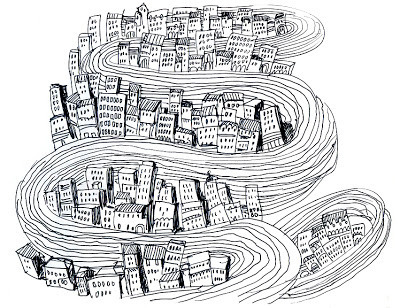
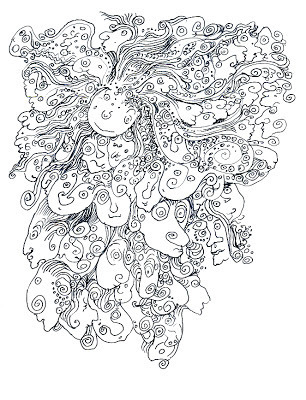



Published on November 12, 2012 10:18

